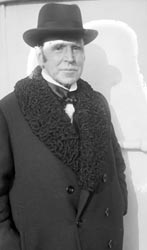
Lavery was born in North Queen Street, Belfast, the son of a wine and spirit merchant, but was orphaned at the age of three and for a number of unsettled years wandered between Moira, Magheralin, Saltcoats, Ayrshire and Glasgow. Finally he got a job touching up photographic negatives in Glasgow and attended evening classes at the Haldane Academy of Art there. When a studio he had set up on his own was burned down he used the insurance money to study further in London and Paris (at the Académie Julian). An early work of his was actually hung next to Manet's Bar at the Folies Bergère at the 1882 salon.
He painted at the village of Grès-sur-Loing before returning to Scotland with Alexander Roche. They, and some fellow artists, achieved success as the so-called "Glasgow boys," but Lavery soon moved on to London where he became a fashionable portrait painter with a studio at 5, Cromwell Place and a house in Tangier. He painted everyone from Winston Churchill to John McCormack, and was also commissioned to record the key events of the Irish Civil War; his wife - the American socialite beauty Hazeel Martyn, whose portrait was later used on Irish banknotes - was passionately committed to the Irish cause and had a relationship with Michael Collins. Honours were showered on Lavery, culminating in a knighthood in 1918.
On the occasion of its opening he donated 35 of his paintings to the Belfast- now Ulster - Museum; they include the well-known Bridge at Grès. A triptych of his, The Madonna Of The Lakes (using his wife and step-daughter as models), is in St Patrick's R.C. Church, Donegall Street (where he himself had been baptised). His widow presented a further collection of his works to the Hugh Lane Gallery in Dublin.
He died in 1941, having published an autobiography "Life Of A Painter" the previous year..